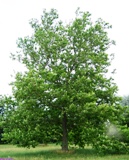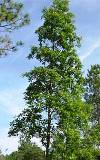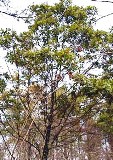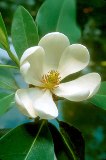Discover Florida Nature
It's time to explore the natural Florida


|
|
|
|
|
A "tree" as described here is defined as a perennial woody stemmed
plant, generally having a single main stem (trunk),13 feet tall or more
at maturity. The term "shrub" denotes a woody stemmed plant usually
having multiple stems (trunks) that never or rarely exceed 13 feet in
height. While in some cases a plant that usually grows as a tree may
assume a shrub-like habit of growth the opposite is also true, some
shrubs will occasionally attain a trees stature. We have listed our
trees and shrubs alphabetically by their common name. All trees of the
same type are listed together (such as all oak trees or all mangrove
trees) With each tree or shrub we have added a photograph for easy
identification, along with a brief description and the scientific name
of the tree.  American
Persimmon (Diospyros virginiana) - The genus name for the
American Persimmon means "Fruit of the Gods". This is a reference to the
delicious golden-orange fruits that often hang on the tree after the
leaves drop in autumn. When ripe, these fruits are very sweet. The
American Persimmon can make an attractive mid-size yard tree. The large
drooping leaves give it a soft look, and the dark checkered bark of
mature trees provides winter interest. The bell-shaped pistillate
flowers are an appealing creamy-yellow, very fragrant, and an excellent
nectar source for honeybees. The tree is tough and adaptable, grows
rapidly, and its deep tap root gives it good drought resistance. It can
survive in shade, but grows and fruits best in sun. American
Persimmon (Diospyros virginiana) - The genus name for the
American Persimmon means "Fruit of the Gods". This is a reference to the
delicious golden-orange fruits that often hang on the tree after the
leaves drop in autumn. When ripe, these fruits are very sweet. The
American Persimmon can make an attractive mid-size yard tree. The large
drooping leaves give it a soft look, and the dark checkered bark of
mature trees provides winter interest. The bell-shaped pistillate
flowers are an appealing creamy-yellow, very fragrant, and an excellent
nectar source for honeybees. The tree is tough and adaptable, grows
rapidly, and its deep tap root gives it good drought resistance. It can
survive in shade, but grows and fruits best in sun. American
Sycamore (Platanus occidentalis) - Sometimes called the
American Planetree, the American Sycamore is a massive tree reaching 75
to 90 feet in height, has a rapid growth rate, and tolerates wet and
compacted soil. This deciduous tree has a smooth almost white bark when
mature. The bark will flake off in irregular thin pieces which give
American Sycamore trees an impressive mottled appearance. Sycamore trees
have light green colored leaves that turn golden in the fall providing
contrasting fall color. The American Sycamore has moderate water
requirements and exhibits a moderate tolerance to salt and alkali soils.
It is a very popular city tree for adverse urban conditions and soils.
The sycamore grows best in zones 4 through 7, but there are reports of
it growing as far north as Minnesota and as far south as Palm Beach,
Florida. American
Sycamore (Platanus occidentalis) - Sometimes called the
American Planetree, the American Sycamore is a massive tree reaching 75
to 90 feet in height, has a rapid growth rate, and tolerates wet and
compacted soil. This deciduous tree has a smooth almost white bark when
mature. The bark will flake off in irregular thin pieces which give
American Sycamore trees an impressive mottled appearance. Sycamore trees
have light green colored leaves that turn golden in the fall providing
contrasting fall color. The American Sycamore has moderate water
requirements and exhibits a moderate tolerance to salt and alkali soils.
It is a very popular city tree for adverse urban conditions and soils.
The sycamore grows best in zones 4 through 7, but there are reports of
it growing as far north as Minnesota and as far south as Palm Beach,
Florida. Bay
Trees- The Loblolly Bay, Swamp Bay, and Sweet Bay are all
Florida native. Despite their names, they are not related to each
other, but have the same shaped leaves. The name ‘Bay tree’ comes from
the spicy Laurel Bay Bay
Trees- The Loblolly Bay, Swamp Bay, and Sweet Bay are all
Florida native. Despite their names, they are not related to each
other, but have the same shaped leaves. The name ‘Bay tree’ comes from
the spicy Laurel Bay  Sweet
Bay
(Magnolia virginiana)- Sometimes called the Sweet
Bay
(Magnolia virginiana)- Sometimes called the |
|
|
Advertise | Privacy Statement | Dog Encyclopedia | Video |Contact | Alaska Nature |
|